

GT!Blog » Japanese Typewriters. With several thousand characters to contend with, how were the Japanese able to use typewriters before the advent of digital technology?
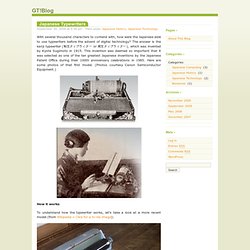
The answer is the kanji typewriter (和文タイプライター or 邦文タイプライター), which was invented by Kyota Sugimoto in 1915. This invention was deemed so important that it was selected as one of the ten greatest Japanese inventions by the Japanese Patent Office during their 100th anniversary celebrations in 1985. Here are some photos of that first model. (Photos courtesy Canon Semiconductor Equipment.) How it works To understand how the typewriter works, let’s take a look at a more recent model (from Wikipedia – Click for a hi-res image): The actual strikers that produce the type are all separate metal pieces, somewhat like movable type, arranged in a grid in the tray (1) beneath the typewriter.
A handle (2) on the typewriter is used select the character to type from the list (3) of characters shown at the front of the typewriter. The actual typing mechanism Related Posts. 日本語資源 - Nihongoresources.com. Where do the kana come from The simple answer to this question is: "from kanji".

While kanji are used as semantic symbols in modern Japanese, this hasn't always been the case, as kanji were quite often used purely for phonetic purpose, using whatever kanji was available to get the sound of the what was written down across without paying attention to the meaning of the actual kanji used. Through this use a "standard" set of kanji became used to mimic Japanese phonetics, and it is from this set that hiragana and katana were derived. Hiragana was derived from the cursive forms of kanji, and was used predominantly by women, while katakana was derived from lifing kanji compounds out of their kanji and using them as phonetic characters instead.
This script was deemed unsuited for women and was used by men, as well as in the clergy (which at the time of course constisted only of men anyway) あ行 The あ column syllable derivations come from 安, 以, 宇, 衣 and 於 for あ, い, う, え and お respectively. か行 さ行 た行 な行. 実用フリー(無料)フォントリンク集・・・日本語(筆文字・毛筆体・行書体・草書体など) 日本語(筆文字・毛筆体・行書体・草書体など) 青柳衡山 無料フォント集 書家の青柳衡山先生が揮毫及び作成された毛筆フォント(筆文字)です。
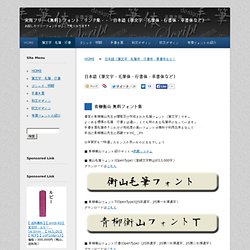
よくある標準の毛筆・行書とは違い、とても味のある毛筆体になっています。 手書き風毛筆体! これだけ完成度の高いフォントが無料で利用出来るなんて・・・ 本当に青柳衡山先生に感謝ですm(_ _)m ◎年賀状も一味違ったセンスの良いものになるでしょう ■ 青柳衡山フォント紹介サイト→武蔵システム ■ 衡山毛筆フォント(OpenType)(登録文字数は約13,000字) ダウンロードはこちら ■ 青柳衡山フォントT(OpenType)(JIS非漢字、JIS第一水準漢字) ダウンロードはこちら ■ 青柳衡山フォント行書(OpenType)(JIS非漢字、JIS第一水準漢字、JIS第二水準漢字) ダウンロードはこちら ■ 衡山フォント草書(OpenType)(JIS非漢字、JIS第一水準漢字、JIS第二水準漢字) ダウンロードはこちら ■ 青柳疎石フォント(OpenType)(JIS非漢字、JIS第一水準漢字、JIS第二水準漢字) ダウンロードはこちら ■ 青柳隷書しもフォント(OpenType) ダウンロードはこちら 漢字第一水準の2,965字、及びひらがなカタカナと僅かの記号のみ含まれています。 Windows用 EPSON TrueTypeFont Ver3.0 エプソン純正のフォントセットです。
【ご使用条件】 エプソンプリンタをご使用になる目的においてのみ、本ソフトウェアをご使用いただけます。 ■ EPSON 教科書体M ■ EPSON 行書体M ■ EPSON 正楷書体M. 日本語資源 - Nihongoresources.com. Japanese scripts Japanese has, like most languages, a few different writing styles.
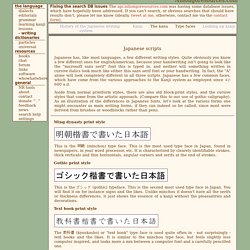
Quite obviously you know a few different ones for english/american, because your handwriting isn't going to look like the "microsoft sans serif" font this is typed in, and neither will something written in cursive italics look much like either this sans serif font or your handwriting. In fact, the "A" alone will look completely different in all three scripts. Japanese has a few common faces, which have come from the various approaches to the Kanji system as employed since +/- 600 a.d.
Aside from normal printform styles, there are also old block-print styles, and the cursive styles that come from the artistic approach. Ming (typeface) Ming or Song is a category of typefaces used to display Chinese characters, which are used in the Chinese, Japanese, and Korean languages.
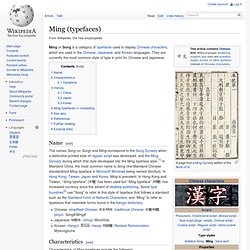
They are currently the most common style of type in print for Chinese and Japanese. The names Song (or Sung) and Ming correspond to the Song Dynasty when a distinctive printed style of regular script was developed, and the Ming Dynasty during which that style developed into the Ming typeface style.[1] In Mainland China, the most common name is Song (the Mainland Chinese standardized Ming typeface in Microsoft Windows being named SimSun). In Hong Kong, Taiwan, Japan and Korea, Ming is prevalent. In Hong Kong and Taiwan, “Song typeface” (宋體) has been used but “Ming typeface” (明體) has increased currency since the advent of desktop publishing.
Chinese: simplified Chinese: 宋体/明体; traditional Chinese: 宋體/明體; pinyin: Sòngtǐ/MíngtǐJapanese: 明朝体; rōmaji: MinchōtaiKorean: Hangul: 명조체; Hanja: 明朝體; Revised Romanization: Myeongjoche Ming typefaces (明朝, Minchō? Edomoji. Edomoji (江戸文字 : えどもじ?)
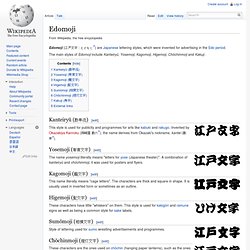
Are Japanese lettering styles, which were invented for advertising in the Edo period. The main styles of Edomoji include Kanteiryū, Yosemoji, Kagomoji, Higemoji, Chōchinmoji and Kakuji . Kanteiryū (勘亭流)[edit] This style is used for publicity and programmes for arts like kabuki and rakugo. Invented by Okazakiya Kanroku (岡崎屋 勘六?) Yosemoji (寄席文字)[edit] The name yosemoji literally means "letters for yose (Japanese theater)". Kagomoji (籠文字)[edit] This name literally means "cage letters". Higemoji (髭文字)[edit] These characters have little "whiskers" on them. Sumōmoji (相撲文字)[edit] Style of lettering used for sumo wrestling advertisements and programmes. List of CJK typefaces.